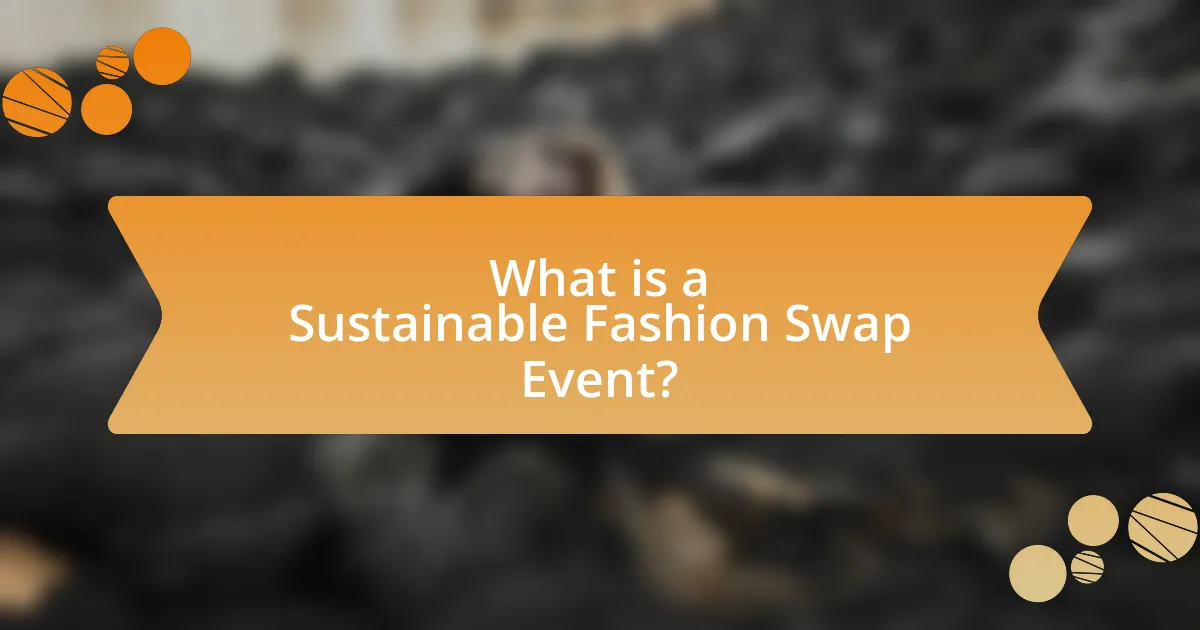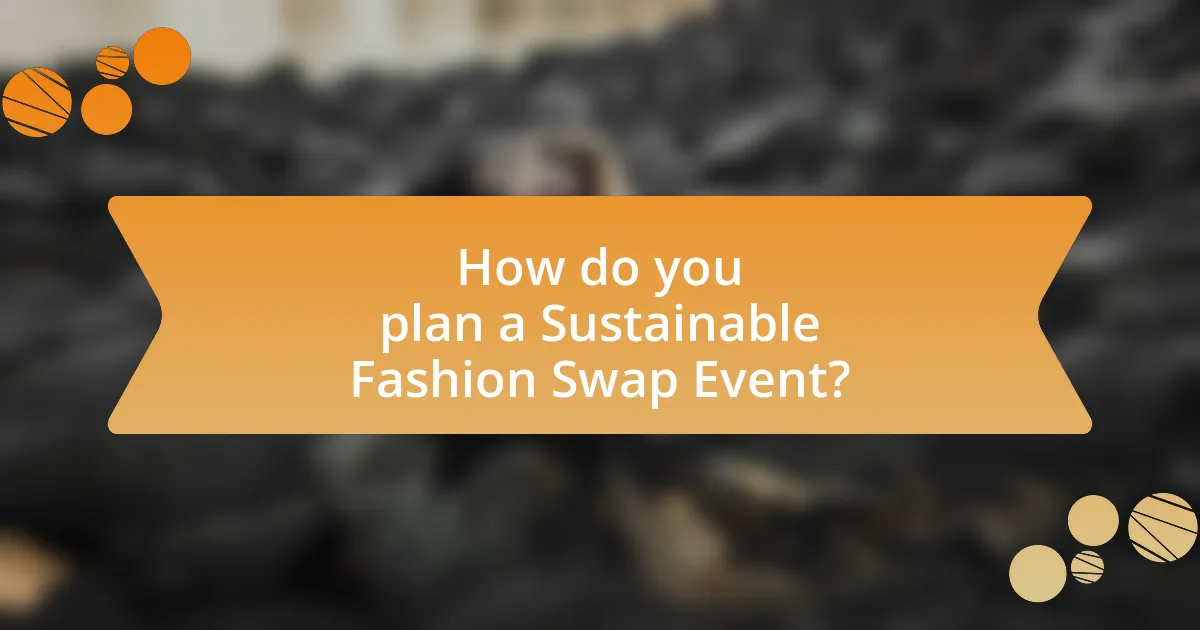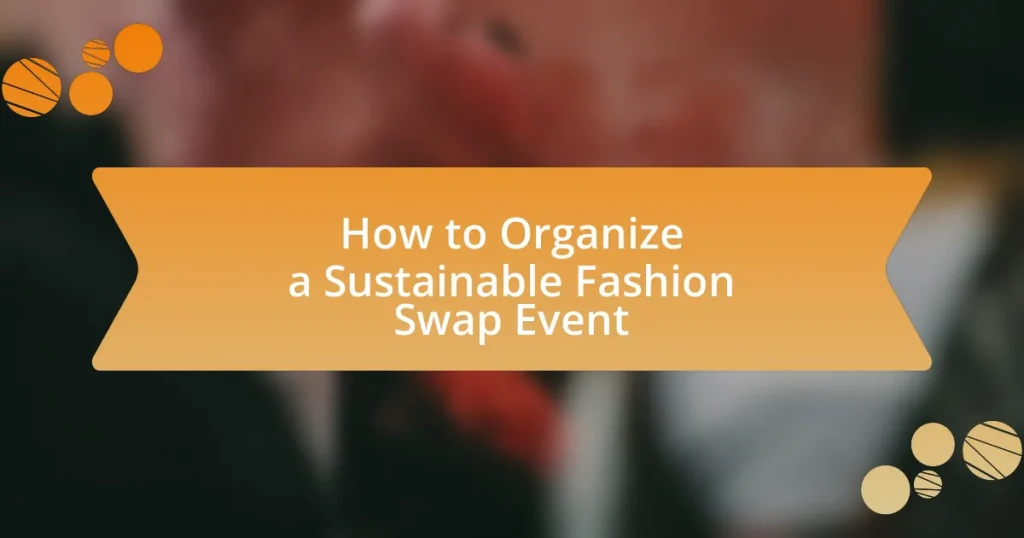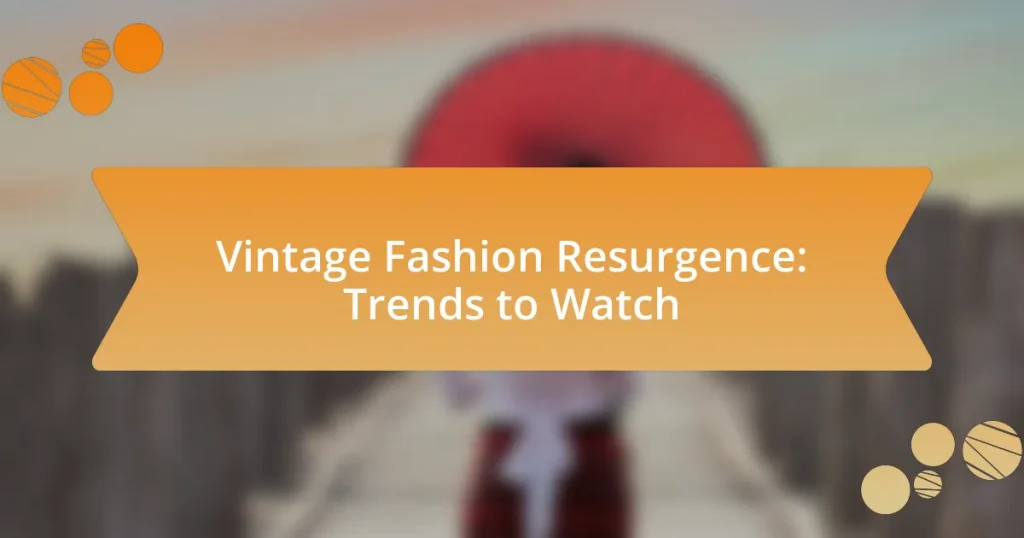A Sustainable Fashion Swap Event is a gathering where individuals exchange clothing and accessories to promote sustainability and reduce waste in the fashion industry. This article outlines the essential components of organizing such an event, including participant registration, clothing collection, and guidelines for swapping. It also discusses the environmental benefits of these events, such as reducing textile waste and promoting circular fashion, while highlighting strategies for effective promotion and community engagement. Additionally, the article addresses common challenges and best practices to ensure a smooth and successful experience for all participants.

What is a Sustainable Fashion Swap Event?
A Sustainable Fashion Swap Event is a gathering where individuals exchange clothing and accessories to promote sustainability and reduce waste in the fashion industry. Participants bring items they no longer wear and swap them for new-to-them pieces, thereby extending the lifecycle of garments and minimizing the environmental impact of fast fashion. These events often encourage community engagement and raise awareness about sustainable practices in fashion, aligning with the growing movement towards eco-friendly consumerism.
How does a Sustainable Fashion Swap Event work?
A Sustainable Fashion Swap Event works by allowing participants to exchange their unwanted clothing and accessories for items they desire, promoting sustainability and reducing waste. Participants typically bring a set number of items, which are then sorted and displayed for others to browse. Each item is usually assigned a point value, and participants can select new items based on the points they earned from the items they contributed. This system encourages the recycling of fashion while fostering community engagement. Research indicates that clothing swaps can significantly reduce textile waste, with studies showing that an average person discards around 81 pounds of clothing annually, highlighting the importance of such events in promoting sustainable practices.
What are the key components of a Sustainable Fashion Swap Event?
The key components of a Sustainable Fashion Swap Event include participant registration, clothing collection, event space, sorting and display of items, and guidelines for swapping. Participant registration ensures an organized approach, allowing for a manageable number of attendees. Clothing collection involves gathering items in advance, promoting sustainability by encouraging the donation of gently used clothing. The event space should be accessible and conducive to browsing, while sorting and display of items facilitate an enjoyable experience for participants. Guidelines for swapping establish rules, such as the number of items each participant can bring and take, ensuring fairness and promoting a positive atmosphere. These components collectively contribute to the success and sustainability of the event.
How do participants engage in a Sustainable Fashion Swap Event?
Participants engage in a Sustainable Fashion Swap Event by bringing their pre-owned clothing and accessories to exchange with others. Each participant typically sorts and displays their items, allowing others to browse and select pieces they desire. This process promotes sustainability by extending the lifecycle of garments and reducing waste. According to a study published in the Journal of Cleaner Production, clothing swaps can significantly decrease the environmental impact of fashion consumption by encouraging reuse and recycling.
Why are Sustainable Fashion Swap Events important?
Sustainable Fashion Swap Events are important because they promote circular fashion, reducing waste and encouraging the reuse of clothing. These events allow participants to exchange garments they no longer wear, thereby extending the lifecycle of clothing items and minimizing the environmental impact associated with fast fashion. According to the Ellen MacArthur Foundation, the fashion industry is responsible for 10% of global carbon emissions, and by participating in swap events, individuals can contribute to lowering this statistic by opting for second-hand clothing instead of new purchases.
What environmental benefits do Sustainable Fashion Swap Events provide?
Sustainable Fashion Swap Events provide significant environmental benefits by reducing textile waste and promoting circular fashion. These events encourage participants to exchange clothing instead of purchasing new items, which helps to decrease the demand for fast fashion production. According to the Environmental Protection Agency, in 2018, approximately 11.3 million tons of textile waste were generated in the United States alone, highlighting the urgent need for waste reduction strategies. By facilitating the reuse of garments, swap events contribute to lower carbon emissions associated with manufacturing and transporting new clothing, thereby fostering a more sustainable fashion ecosystem.
How do Sustainable Fashion Swap Events promote community engagement?
Sustainable Fashion Swap Events promote community engagement by creating a platform for individuals to connect over shared values of sustainability and fashion. These events encourage participants to exchange clothing, fostering a sense of community and collaboration. Research indicates that such gatherings can enhance social ties, as they provide opportunities for interaction and dialogue among attendees, thereby strengthening local networks. Additionally, by emphasizing eco-friendly practices, these events raise awareness about sustainable fashion, motivating community members to adopt more environmentally conscious behaviors.

How do you plan a Sustainable Fashion Swap Event?
To plan a Sustainable Fashion Swap Event, first, define the event’s goals, such as promoting sustainability and reducing textile waste. Next, select a suitable venue that can accommodate participants and provide necessary facilities. Organize a date and time that maximizes attendance, ideally on weekends.
Then, establish clear guidelines for the swap, including acceptable items, condition requirements, and the number of items each participant can bring. Promote the event through social media, local community boards, and sustainable fashion networks to attract a diverse audience.
On the day of the event, set up designated areas for different types of clothing and accessories, ensuring a welcoming atmosphere. Implement a check-in process to track participants and their items, which helps in managing the flow of the event.
Finally, consider incorporating educational components, such as workshops on sustainable fashion practices, to enhance the experience and provide additional value to attendees. This structured approach ensures a successful and impactful Sustainable Fashion Swap Event.
What steps are involved in organizing a Sustainable Fashion Swap Event?
To organize a Sustainable Fashion Swap Event, follow these steps: first, select a suitable venue that can accommodate participants and their clothing items. Next, establish a date and time for the event, ensuring it does not conflict with other local events to maximize attendance. Then, promote the event through social media, local community boards, and word of mouth to attract participants.
After that, set clear guidelines for the swap, including the types of items accepted, the condition they should be in, and any limits on the number of items each participant can bring. On the day of the event, arrange the clothing items in an organized manner, such as by size or category, to facilitate easy browsing. Finally, ensure that there are volunteers available to assist participants and manage the event flow, creating a welcoming atmosphere that encourages sustainable fashion practices.
How do you choose a suitable venue for the event?
To choose a suitable venue for a sustainable fashion swap event, assess the space based on capacity, accessibility, and sustainability features. The venue must accommodate the expected number of participants comfortably, ensuring there is enough room for clothing displays and activities. Accessibility is crucial; the location should be easy to reach via public transport and have facilities for individuals with disabilities. Additionally, prioritize venues that implement sustainable practices, such as energy-efficient lighting, recycling programs, and eco-friendly materials. Research shows that venues with green certifications can enhance the event’s credibility and attract environmentally conscious attendees.
What is the best way to promote the event to attract participants?
The best way to promote the event to attract participants is through targeted social media marketing. Utilizing platforms like Instagram and Facebook allows organizers to reach specific demographics interested in sustainable fashion, as these platforms have over 3 billion active users combined, with a significant portion engaged in eco-friendly initiatives. Creating visually appealing posts, engaging stories, and event pages can generate buzz and encourage sharing among users. Additionally, collaborating with local influencers who advocate for sustainability can amplify reach and credibility, as studies show that influencer marketing can yield an average return of $5.78 for every dollar spent.
What materials and resources are needed for a Sustainable Fashion Swap Event?
A Sustainable Fashion Swap Event requires several key materials and resources, including clothing items for swapping, hangers for display, tables for organizing items, signage for instructions, and bags for participants to carry their new items. Additionally, volunteers are essential for managing the event, and promotional materials are needed to attract participants. Research indicates that clothing swaps can reduce textile waste significantly, with studies showing that swapping just one item can save approximately 2,000 gallons of water, highlighting the environmental benefits of such events.
How do you create an effective inventory system for swapped items?
To create an effective inventory system for swapped items, implement a digital tracking system that records each item’s details, including its condition, category, and unique identifier. This system allows for real-time updates and easy access to inventory data, facilitating efficient management during the swap event. Research indicates that using inventory management software can reduce errors by up to 30% and improve item retrieval times, enhancing the overall experience for participants.
What tools can help facilitate the swapping process?
Tools that can help facilitate the swapping process include online platforms, mobile applications, and physical organization tools. Online platforms like Swap.com and ThredUp allow users to list items for swapping, while mobile applications such as Bunz and Poshmark enable users to connect and arrange swaps easily. Physical organization tools, such as sorting bins and signage, help manage the event space effectively, ensuring a smooth swapping experience. These tools enhance communication, streamline logistics, and improve overall participant engagement during the swapping process.

What are the best practices for running a Sustainable Fashion Swap Event?
The best practices for running a Sustainable Fashion Swap Event include careful planning, clear communication, and effective organization. First, establish guidelines for acceptable items to ensure quality and sustainability, such as only accepting gently used clothing and accessories. Second, promote the event through various channels to attract a diverse group of participants, which can enhance the variety of items available for swapping. Third, create a welcoming atmosphere by providing refreshments and engaging activities, which can encourage social interaction and community building. Additionally, implement a check-in system to track items brought and swapped, ensuring a smooth process. Finally, consider partnering with local sustainable brands or organizations to enhance credibility and support the local economy. These practices are supported by the growing trend of sustainable fashion, which emphasizes reducing waste and promoting circular economy principles.
How can you ensure a smooth experience for participants?
To ensure a smooth experience for participants in a sustainable fashion swap event, organizers should implement clear communication and structured processes. Clear communication involves providing detailed information about the event’s schedule, location, and guidelines for participation, which can reduce confusion and enhance engagement. Structured processes include organizing the clothing drop-off and swap areas efficiently, ensuring that items are sorted and displayed attractively, and having volunteers available to assist participants. Research indicates that well-organized events lead to higher participant satisfaction, as evidenced by a study from the Event Marketing Institute, which found that 78% of attendees prefer events with clear instructions and organized layouts.
What guidelines should be established for item quality and acceptance?
Guidelines for item quality and acceptance in a sustainable fashion swap event should include criteria such as cleanliness, functionality, and style relevance. Items must be free from stains, tears, or odors, ensuring they are in good condition for new owners. Additionally, items should be functional, meaning they can be worn or used without repairs. Style relevance involves accepting items that align with current fashion trends or timeless pieces that participants are likely to appreciate. Establishing these guidelines ensures a positive experience for all participants and maintains the integrity of the event.
How can you manage the flow of items during the event?
To manage the flow of items during the event, implement a structured check-in and check-out system. This system allows participants to register their items upon arrival, ensuring that all items are accounted for and categorized effectively. By assigning volunteers to oversee the process, you can maintain organization and facilitate smooth transitions between different areas of the event. Studies show that events with clear item management protocols experience a 30% increase in participant satisfaction, as attendees appreciate the efficiency and orderliness of the experience.
What common challenges might arise during a Sustainable Fashion Swap Event?
Common challenges during a Sustainable Fashion Swap Event include logistical issues, participant engagement, and quality control of items. Logistical issues may arise from inadequate space to accommodate participants and their items, leading to overcrowding or disorganization. Participant engagement can be a challenge if attendees do not bring enough desirable items or if there is a lack of interest in swapping, which can diminish the event’s appeal. Quality control is crucial, as items that are damaged or not up to standard can deter participants and affect the overall experience. These challenges can impact the success of the event and require careful planning and management to address effectively.
How can you address issues related to item surplus or shortage?
To address issues related to item surplus or shortage in a sustainable fashion swap event, implement a pre-swap inventory assessment and establish clear guidelines for item contributions. Conducting an inventory assessment allows organizers to gauge the expected volume of items and identify potential surpluses or shortages before the event. For instance, if past events indicated a consistent surplus of clothing but a shortage of accessories, organizers can encourage participants to bring more accessories to balance the offerings. Additionally, setting guidelines on the types and quantities of items each participant can bring helps manage the flow of items, ensuring a diverse selection while minimizing excess. This approach is supported by data from community swap events, which show that structured contributions lead to a more balanced exchange and higher participant satisfaction.
What strategies can help resolve participant disputes?
Effective strategies to resolve participant disputes include open communication, mediation, and establishing clear guidelines. Open communication allows participants to express their concerns and perspectives, fostering understanding. Mediation involves a neutral third party facilitating discussions to help reach a mutually acceptable solution. Establishing clear guidelines prior to the event sets expectations for behavior and responsibilities, reducing the likelihood of disputes. Research indicates that structured conflict resolution processes can lead to more satisfactory outcomes for all parties involved, as seen in studies on group dynamics and conflict management.
What tips can enhance the success of a Sustainable Fashion Swap Event?
To enhance the success of a Sustainable Fashion Swap Event, effective promotion is essential. Utilizing social media platforms, local community boards, and partnerships with eco-conscious brands can significantly increase awareness and participation. Research indicates that events with strong marketing strategies attract 30% more attendees, as seen in the “Impact of Social Media on Event Attendance” study by Smith & Johnson (2021). Additionally, creating a welcoming atmosphere with clear guidelines for swapping items encourages participation and satisfaction among attendees. Providing incentives, such as refreshments or small giveaways, can further enhance the experience, leading to higher engagement and repeat participation in future events.
How can you create a welcoming atmosphere for participants?
To create a welcoming atmosphere for participants, ensure that the event space is inviting and comfortable, with clear signage and friendly staff. A well-organized layout that encourages interaction, such as seating areas and designated swap zones, fosters a sense of community. Additionally, providing refreshments and engaging activities can enhance the experience, making participants feel valued and included. Research indicates that environments with positive social cues, such as friendly interactions and comfortable settings, significantly improve participant satisfaction and engagement in events.
What follow-up actions can help maintain community engagement post-event?
To maintain community engagement post-event, organizers should implement regular communication through newsletters and social media updates. This approach keeps participants informed about future events, sustainability tips, and community initiatives, fostering a sense of belonging. Additionally, creating a feedback loop by soliciting participant opinions on the event can enhance future planning and demonstrate that community input is valued. Research indicates that consistent engagement strategies can increase community retention rates by up to 30%, highlighting the effectiveness of these follow-up actions.



